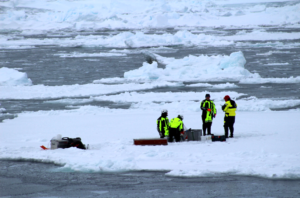Do you think it is possible to stand on an 18 cm thick sea ice floe without breaking through?
Just one week ago we almost got stuck with the ship in about 4 m thick sea ice further south. We couldn’t move south and not back north neither. This was scary and we already imagined how it would be to spend the whole Antarctic winter in the sea ice. As soon as the captain managed to break the ship free, he headed straight north to get out of the sea ice covered area. Although it was good to get into a safer area, we were disappointed that we didn’t get to do all the science we wanted to do closer to the ice shelves. And the most disappointing was that we didn’t get the opportunity to leave the ship and go on sea ice!
But suddenly before leaving the sea ice area for good we stopped for a sea ice station, because there was a perfect homogeneous ice floe that the sea ice scientists were eager to study. So four of the scientists were brought to the ice floe on a small boat and took sea ice cores to measure the thickness, temperature, salinity, phytoplankton content and chemical constellation. In the meanwhile, the rest of us sat in the day room watching them through the windows. We were very jealous at them who could get on the ice! At some point there was an announcement through the speakers: Everyone was allowed to go on the ice floe! This made us so happy that we all ran to get into the floating suits and to enter the small boat. Finally – after four weeks on the ship, we could get off and step onto a piece of ice! We were very excited, jumped on the sea ice, made pyramids, and took a lot of crazy pictures until our hands were frozen! It was amazing and a lot of fun also to see the ship from distance.



Although the ice floe looked very fragile and dangerous to step on, it was stable enough to hold all our jumps. It was fun and only the penguins were missing, but we could live with that. It was a great pay-off after the disappointment of heading north earlier than expected.
